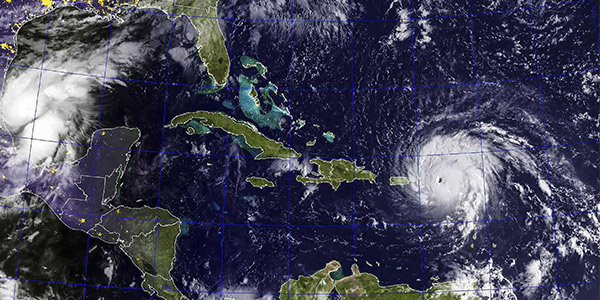Utilities expect their mutual assistance plans to help the U.S. electric grid weather a predicted active Atlantic hurricane season, even in light of the ongoing COVID-19 pandemic, members of the Electric Subsector Coordinating Council (ESCC) said Thursday.
In a media call, Scott Aaronson, Edison Electric Institute vice president for security planning and preparedness, and Stan Connally, executive vice president for operations at Southern Co., said April’s Easter weekend storms provided valuable information that will shape future storm response. Restoring the more than 1 million homes and businesses that lost power required ensuring that all personnel maintained suitable safety measures outlined in the outage response plan that ESCC created at the beginning of the pandemic.
“We were fortunate that we were able to return service to most of [the affected customers] within 24 hours,” Connally said. “But that happened because of the reliance on and the response of our partners. … For these storms, we had over 1,000 mutual assistance workers that responded to us from 10 different states.”
Connally and Aaronson said the response proved to be “a successful test case” for the COVID-19 protocols, with power restored quickly and no coronavirus infections reported among any of the crews that assisted with the Easter storms. But they also acknowledged that scaling up this kind of operation to deal with a major hurricane — of which there could be as many as six this year, according to the National Oceanic and Atmospheric Administration — will require high levels of cooperation from everyone involved.
Distancing Efforts Provide Future Value
Key challenges anticipated by the ESCC are:
- ensuring personnel maintain appropriate social distance while working on service calls;
- maintaining an adequate supply of personal protective equipment (PPE) for service workers; and
- creating contact tracing and testing regimes to find out as soon as possible if exposed employees need to be removed from the front line.
Connally described several ways his company worked to address those issues during the recent storms. Where Southern might normally create large base camps for several thousand workers to eat, sleep and store their vehicles and equipment, the company this time broke up those camps into many smaller staging areas, along with isolating sleeping quarters. This created complications with distributing resources to many more destinations; however, the utility believes the experience will be worthwhile in the long run.
“We may be seeing some advantages of doing that,” Connally said. “For instance, getting the material [pre-distributed] may prove to be a solution that provides us some advantages in terms of restoration time. So [while] you might say there’s additional complication and logistics challenges with the COVID protocols, at the same time we may find some advantages [for] our restoration efforts.”
The social distancing measures have also provided an impetus for utilities to speed up the adoption of new communication technologies that could bring long-term benefits. Instead of gathering personnel in one place for safety or mission briefings, for example, the information can be sent to employees in the field directly, ensuring they have more time for their work.
PPE, Testing Present Ongoing Challenge
With regard to PPE and other essential items, Aaronson said the ESCC has made sure to “constantly pulse the supply chain at all levels” by keeping in contact with all relevant suppliers, and that it has not noted “a specific impact” on the supply chain and logistics despite the stress of the Easter storms. However, continued monitoring is still needed as stocks may be quickly depleted in a major outage scenario.
Testing and contact tracing are another area that still presents difficulty, as utilities usually lack adequate testing capacity to test a sudden influx of field personnel from other states or the time to test them all before they go to work. In these cases, local respondents must rely on the assurance of partner utilities that their workers have not been in contact with infected individuals while keeping distancing measures in place and making sure that all suspicious symptoms are reported as soon as possible.
Despite these ongoing complications, the ESCC remains confident that utilities can work together to ensure safe and continued operation during the hurricane season, which begins June 1. Participants say the industry’s spirit of collaboration will be key.
“What is interesting about this is [that] so much of our continuity planning in this industry actually is rooted in pandemic,” said Aaronson, referring to previous outbreaks such as SARS, MERS, and the avian and swine flus. “Those were all potential threats that presented really interesting thought exercises … [that] really did inform a lot of how this industry works together to do contingency planning against all threats.”





